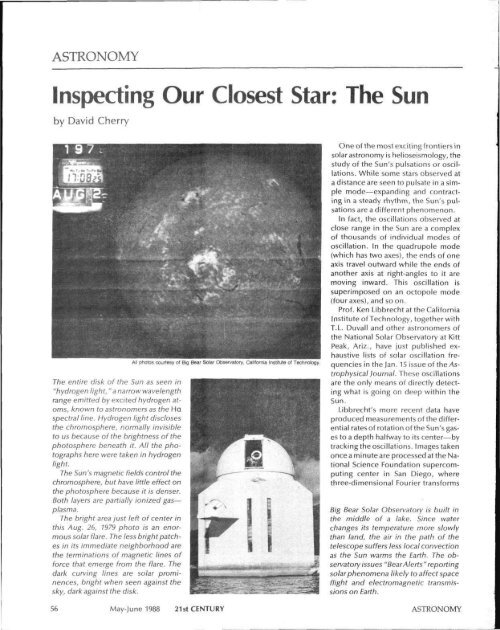The Geometry The Nucleus
The Geometry The Nucleus
The Geometry The Nucleus
You also want an ePaper? Increase the reach of your titles
YUMPU automatically turns print PDFs into web optimized ePapers that Google loves.
ASTRONOMY<br />
Inspecting Our Closest Star: <strong>The</strong> Sun<br />
by David Cherry<br />
<strong>The</strong> entire disk of the Sun as seen in<br />
"hydrogen light, "a narrow wavelength<br />
range emitted by excited hydrogen atoms,<br />
known to astronomers as the Ha<br />
spectral line. Hydrogen light discloses<br />
the chromosphere, normally invisible<br />
to us because of the brightness of the<br />
photosphere beneath it. All the photographs<br />
here were taken in hydrogen<br />
light.<br />
<strong>The</strong> Sun's magnetic fields control the<br />
chromosphere, but have little effect on<br />
the photosphere because it is denser.<br />
Both layers are partially ionized gasplasma.<br />
<strong>The</strong> bright area just left of center in<br />
this Aug. 26, 1979 photo is an enormous<br />
solar flare. <strong>The</strong> less bright patches<br />
in its immediate neighborhood are<br />
the terminations of magnetic lines of<br />
force that emerge from the flare. <strong>The</strong><br />
dark curving lines are solar prominences,<br />
bright when seen against the<br />
sky, dark against the disk.<br />
All photos courtesy of Big Bear Solar Observatory, California Institute of Technology.<br />
One of the most exciting frontiers in<br />
solar astronomy is helioseismology, the<br />
study of the Sun's pulsations or oscillations.<br />
While some stars observed at<br />
a distance are seen to pulsate in a simple<br />
mode—expanding and contracting<br />
in a steady rhythm, the Sun's pulsations<br />
are a different phenomenon.<br />
In fact, the oscillations observed at<br />
close range in the Sun are a complex<br />
of thousands of individual modes of<br />
oscillation. In the quadrupole mode<br />
(which has two axes), the ends of one<br />
axis travel outward while the ends of<br />
another axis at right-angles to it are<br />
moving inward. This oscillation is<br />
superimposed on an octopole mode<br />
(four axes), and so on.<br />
Prof. Ken Libbrecht at the California<br />
Institute of Technology, together with<br />
T.L. Duvall and other astronomers of<br />
the National Solar Observatory at Kitt<br />
Peak, Ariz., have just published exhaustive<br />
lists of solar oscillation frequencies<br />
in the Jan. 15 issue of the Astrophysical<br />
Journal. <strong>The</strong>se oscillations<br />
are the only means of directly detecting<br />
what is going on deep within the<br />
Sun.<br />
Libbrecht's more recent data have<br />
produced measurements of the differential<br />
rates of rotation of the Sun's gases<br />
to a depth halfway to its center—by<br />
tracking the oscillations. Images taken<br />
once a minute are processed at the National<br />
Science Foundation supercomputing<br />
center in San Diego, where<br />
three-dimensional Fourier transforms<br />
Big Bear Solar Observatory is built in<br />
the middle of a lake. Since water<br />
changes its temperature more slowly<br />
than land, the air in the path of the<br />
telescope suffers less local convection<br />
as the Sun warms the Earth. <strong>The</strong> observatory<br />
issues "BearAlerts"reporting<br />
solar phenomena likely to affect space<br />
flight and electromagnetic transmissions<br />
on Earth.<br />
56 May-June 1988 21st CENTURY ASTRONOMY

















